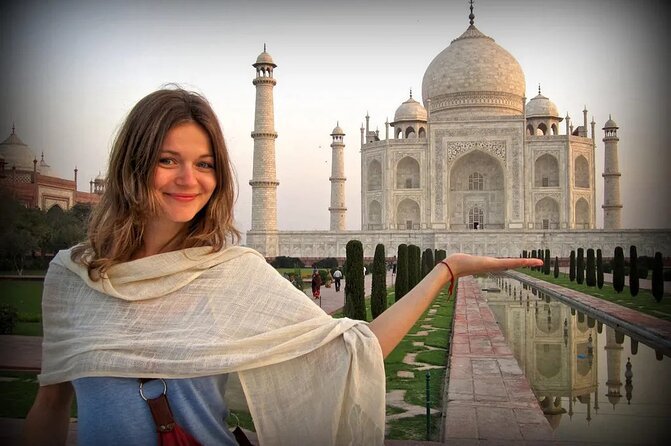When it comes to iconic landmarks in India, the Taj Mahal is undoubtedly one of the most popular destinations for tourists. Its striking architecture, intricate carvings, and stunning gardens are just a few of the things that make it so special.
Discover the Most Fascinating Facts about the Iconic Monument on Your Delhi Agra Tour
Also you like to read Hotel Alpine Agra
However, there are many lesser-known Taj Mahal fun facts that you may not be aware of, especially if you’re planning a Delhi Agra Tour by car. These 10 fun facts about the Taj Mahal will give you a deeper appreciation of this incredible monument and its history.
10 Fascinating Taj Mahal Fun Facts That Will Amaze You.
1. The Taj Mahal was built by Mughal Emperor Shah Jahan in memory of his beloved wife Mumtaz Mahal.
2. The construction of the Taj Mahal took over 22 years to complete.
3. The Taj Mahal changes color throughout the day, from a soft pink hue in the morning to a dazzling white at noon and a golden color in the moonlight.
4. The Taj Mahal is built entirely of white marble, which was transported from Makrana in Rajasthan.
5. The intricate carvings on the walls of the Taj Mahal are not painted but are made of precious and semi-precious stones.

6. The four minarets of the Taj Mahal were designed to tilt slightly outwards so that in the event of an earthquake, they would fall away from the main tomb and not damage it.
7. The Taj Mahal has a unique ventilation system that keeps the monument cool in the summer and warm in the winter.
8. The reflection of the Taj Mahal in the nearby Yamuna River creates a stunning visual effect, especially during sunrise and sunset.
9. The Taj Mahal is a UNESCO World Heritage Site and is considered one of the Seven Wonders of the World.
10. The Taj Mahal attracts millions of visitors every year, making it one of the most popular tourist destinations in the world.
These Taj Mahal fun facts offer just a glimpse into the history and beauty of this iconic monument. If you’re planning a trip to India, be sure to include a visit to the Taj Mahal on your itinerary and discover all that this magnificent structure has to offer.
Exploring the Taj Mahal: Must-Visit Areas During Your Delhi Agra Tour
Here are a few recommendations:
The Main Tomb: This is the central structure of the Taj Mahal, housing the tombs of Mumtaz Mahal and Shah Jahan. The interior of the tomb is decorated with intricate carvings and calligraphy.
The Gardens: The Taj Mahal’s gardens are divided into four sections, with walkways and fountains. They offer a peaceful respite from the crowds and a great view of the monument.
The Minarets: The four minarets that surround the main tomb offer a stunning view of the Taj Mahal and the surrounding area.

The Mosque: Located to the west of the main tomb, the mosque was built to provide a place for Muslims to pray.
The Guest House: Located to the east of the main tomb, the guest house was built to provide accommodations for visitors to the Taj Mahal.
The Yamuna River: The Taj Mahal is located on the banks of the Yamuna River, which offers a beautiful view of the monument and a great photo opportunity.
Make sure to take your time and explore all that the Taj Mahal has to offer during your Delhi Agra Tour. Each area offers a unique perspective and a chance to appreciate the beauty and history of this magnificent monument.
The Best Time of Year to Visit the Taj Mahal: A Guide to Planning Your Trip
If you’re planning a Delhi Agra Tour by car to visit the Taj Mahal, the best time of year to go is during the winter months, from October to March. This season offers pleasant weather with clear skies and cool temperatures, making it ideal for exploring the monument and enjoying some of the Taj Mahal fun facts. During this time, you can expect moderate temperatures ranging from 8°C to 22°C (46°F to 72°F), which is comfortable for sightseeing.

The summer months, from April to June, can be very hot and humid, reaching temperatures of up to 45°C (113°F), which can make it uncomfortable to spend extended periods of time outdoors. The monsoon season, from July to September, can bring heavy rains and flooding, which may make it difficult to access the Taj Mahal. However, visiting during the monsoon season can offer you a chance to experience the Taj Mahal in a unique way, with fewer crowds and lush greenery surrounding the monument.
Overall, the winter months are the most popular time to visit the Taj Mahal, as the weather is comfortable and the crowds are manageable. So if you’re planning a Delhi Agra Tour by car and want to explore the Taj Mahal, be sure to plan your trip during the winter season to make the most of your visit.
Also you like to read Discover the 10 Most interesting facts about the Taj Mahal on Your Delhi Agra Tour by Car
The Taj Mahal is a true marvel of architecture and design, and these fun facts only add to the beauty and mystique of this iconic monument. Whether you are planning a Delhi Agra Tour or simply want to learn more about the Taj Mahal, these interesting facts are sure to impress and inspire you. So why not book your tour today and discover the wonder of the Taj Mahal for yourself?
People Also Asked this
The Taj Mahal’s white marble changes color depending on the time of day and the season.
The Taj Mahal was built using a unique technique where the marble blocks were held together by iron dowels instead of mortar.
The Taj Mahal is not only a mausoleum for Mumtaz Mahal, but it also houses the tomb of Shah Jahan himself.
The Taj Mahal’s gardens are divided into four sections, representing the four rivers of paradise in Islamic tradition.
The Taj Mahal’s calligraphy was done by an Iranian calligrapher, Abd ul-Haq.
The Taj Mahal was built on the banks of the Yamuna River so that its reflection would be seen in the water.
The Taj Mahal was almost destroyed during the Indian Rebellion of 1857, but was saved by British soldiers who recognized its cultural significance.
The Taj Mahal’s minarets were designed to lean slightly outwards so that if they were to fall, they would not damage the main structure.
The Taj Mahal is said to have inspired the construction of other famous buildings, such as the Humayun’s Tomb in Delhi and the Bibi Ka Maqbara in Aurangabad.
The Taj Mahal’s construction required the labor of over 22,000 workers, including artisans, craftsmen, and laborers from all over the Mughal Empire.
Knowing these lesser-known Taj Mahal fun facts can enhance your appreciation of this iconic monument during your Delhi Agra Tour by car.
Practically, the minarets were designed to provide structural support to the main tomb and to serve as a lookout point for guards. The minarets were also built to lean slightly outwards so that in the event of an earthquake, they would fall away from the main tomb and not damage it.
The minarets are an important part of the architectural design of the Taj Mahal, and they add to the overall beauty and symmetry of the monument. Visitors to the Taj Mahal on a Delhi Agra Tour by car often enjoy exploring the minarets and taking in the stunning views of the surrounding area.
The Taj Mahal is located in Agra, India and is one of the most popular tourist destinations in the country. Visitors on a Delhi Agra Tour by car can explore the monument and learn about its rich history and architecture.
During the construction of the Taj Mahal, over 20,000 workers were employed, including architects, craftsmen, and laborers from all over the Mughal Empire. The white marble used to construct the monument was transported from the quarries of Makrana in Rajasthan by a fleet of over 1,000 elephants.
Today, the Taj Mahal is considered one of the Seven Wonders of the World and is a UNESCO World Heritage Site. Its stunning beauty and rich history continue to attract millions of visitors from around the world each year.
During the construction of the Taj Mahal, the marble blocks were carved with grooves and ridges, into which the iron dowels were inserted. The dowels were then heated and cooled, causing them to expand and contract, which helped to hold the marble blocks in place. This technique is known as the “pietra dura” technique, which means “hard stone” in Italian.
The use of this technique allowed the Taj Mahal to withstand earthquakes and other natural disasters over the centuries. Visitors on a Delhi Agra Tour by car can see firsthand the intricate details and craftsmanship of the Taj Mahal’s construction, including the unique technique used to hold the marble blocks together.
The calligraphy on the Taj Mahal is considered to be some of the finest examples of Islamic calligraphy in the world. It is said that more than 28 different types of precious and semi-precious stones were used to create the intricate designs.
The calligraphy on the walls of the Taj Mahal includes verses from the Quran, as well as other poems and inscriptions in Arabic and Persian. Visitors on a Delhi Agra Tour by car can marvel at the beauty and intricacy of the calligraphy, which adds to the overall grandeur of the monument.
The Taj Mahal’s design and grandeur have influenced many other famous buildings around the world. One of the most notable examples is the Humayun’s Tomb in Delhi, which was built in a similar Mughal architectural style. The Bibi Ka Maqbara in Aurangabad is also said to have been inspired by the Taj Mahal, as it was built by the son of the Mughal Emperor Aurangzeb as a tribute to his mother.
Other examples of buildings that have been inspired by the Taj Mahal’s grandeur include the Taj Mahal Palace Hotel in Mumbai, the Taj Mahal replica in Bangladesh, and the Minar-e-Pakistan monument in Lahore, Pakistan.
Visitors on a Delhi Agra Tour by car can explore the Taj Mahal and learn about its rich history and architectural influence on other famous buildings around the world.
The gardens are meant to represent the Islamic concept of paradise and are designed to be a reflection of the paradise described in the Quran. The gardens are also meant to symbolize the four rivers of paradise.
The Charbagh gardens are divided into four quadrants by two main walkways that intersect at the center of the gardens. They are also bisected by four water channels that originate from a central water tank. The water channels are lined with fountains and are meant to reflect the symmetry and beauty of the Taj Mahal.
The gardens surrounding the Taj Mahal are an important part of its design and are meant to complement the beauty and grandeur of the monument itself. Visitors on a Delhi Agra Tour by car can walk through the gardens and appreciate their intricate design and symbolism.
However, the British army arrived in time to save the Taj Mahal from destruction. The British soldiers recognized the cultural significance of the monument and ordered their troops not to fire on it. They also stationed guards around the Taj Mahal to protect it from further damage.
During the rebellion, the Taj Mahal’s gardens and fountains were damaged, and several precious stones were stolen from its walls. However, thanks to the efforts of the British soldiers, the Taj Mahal was saved from complete destruction.
Today, the Taj Mahal is a UNESCO World Heritage Site and is considered one of the greatest examples of Mughal architecture in the world. Visitors on a Delhi Agra Tour by car can learn about the monument’s rich history and appreciate its beauty and grandeur.
The reason for this color change is due to the type of marble used to construct the Taj Mahal. The marble used is called Makrana marble, which is a type of white marble with a high degree of translucency. As the sun moves across the sky, the sunlight passes through the marble, creating a soft glow that changes in color throughout the day.
Another factor that affects the color of the Taj Mahal is the season. During the monsoon season, the Taj Mahal can appear to be a hazy blue color, due to the moisture in the air.
Visitors on a Delhi Agra Tour by car can witness the changing colors of the Taj Mahal throughout the day, making it a truly magical experience. The beauty of the monument is further enhanced by the natural light that illuminates it, giving it a unique and ethereal quality.
The construction of the Taj Mahal was a massive undertaking that required the labor of skilled artisans and craftsmen. The marble used to construct the monument was transported from the quarries of Makrana in Rajasthan by a fleet of over 1,000 elephants.
The workers involved in the construction of the Taj Mahal were highly skilled in their respective trades, and the monument’s construction required the mastery of many different skills, including calligraphy, inlay work, and stone carving.
Today, the Taj Mahal is considered one of the greatest examples of Mughal architecture in the world and is a UNESCO World Heritage Site. Visitors on a Delhi Agra Tour by car can explore the monument and learn about its rich history and the incredible skill and craftsmanship that went into its construction.




























